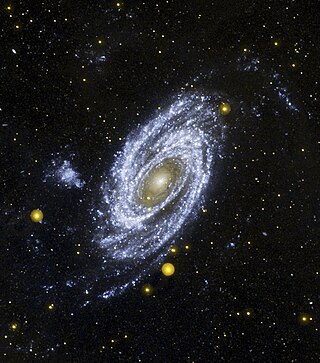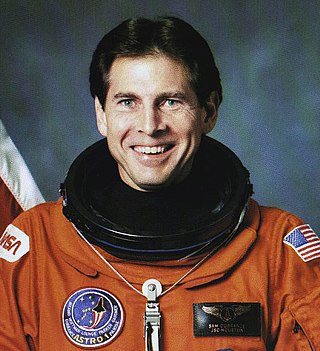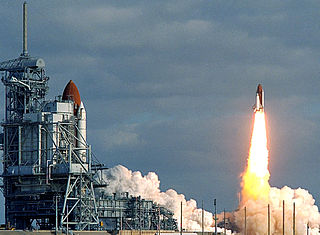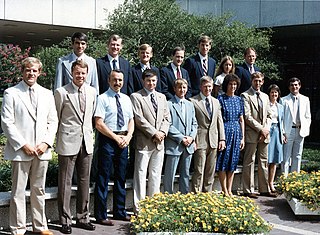
Ultraviolet astronomy is the observation of electromagnetic radiation at ultraviolet wavelengths between approximately 10 and 320 nanometres; shorter wavelengths—higher energy photons—are studied by X-ray astronomy and gamma-ray astronomy. Ultraviolet light is not visible to the human eye. Most of the light at these wavelengths is absorbed by the Earth's atmosphere, so observations at these wavelengths must be performed from the upper atmosphere or from space.

STS-35 was the tenth flight of Space Shuttle Columbia, the 38th shuttle flight, and a mission devoted to astronomical observations with ASTRO-1, a Spacelab observatory consisting of four telescopes. The mission launched from Kennedy Space Center in Florida on December 2, 1990.

Steven Alan Hawley is a former NASA astronaut who flew on five U.S. Space Shuttle flights. He is professor of physics and astronomy and director of engineering physics at the University of Kansas.

STS-85 was a Space Shuttle Discovery mission to perform multiple space science packages. It was launched from Kennedy Space Center, Florida, on 7 August 1997. A major experiment was the CRISTA-SPAS free-flyer which had various telescopes on board.

STS-66 was a Space Shuttle program mission that was flown by the Space Shuttle Atlantis. STS-66 launched on 3 November 1994 at 11:59:43.060 am EDT from Launch Pad 39-B at NASA's Kennedy Space Center. Atlantis landed at Edwards Air Force Base on 14 November 1994 at 10:33:45 am EST.

STS-67 was a human spaceflight mission using Space ShuttleEndeavour that launched from Kennedy Space Center, Florida on 2 March 1995.

STS-95 was a Space Shuttle mission launched from Kennedy Space Center, Florida on 29 October 1998, using the orbiter Discovery. It was the 25th flight of Discovery and the 92nd mission flown since the start of the Space Shuttle program in April 1981. It was a highly publicized mission due to former Project Mercury astronaut and United States Senator John H. Glenn Jr.'s return to space for his second space flight. At age 77, Glenn became the oldest person to go into space, a record that remained unbroken for 23 years until 82-year-old Wally Funk flew on a suborbital flight on Blue Origin NS-16, launching on 20 July 2021, which in turn was broken by William Shatner at age 90 on 13 October 2021. Glenn, however, remains the oldest person to reach Earth orbit. This mission is also noted for inaugurating ATSC HDTV broadcasting in the U.S., with live coast-to-coast coverage of the launch. In another first, Pedro Duque became the first Spaniard in space.

Jeffrey Alan Hoffman is an American former NASA astronaut and currently a professor of aeronautics and astronautics at MIT.

Samuel Thornton Durrance (Ph.D.) is an American scientist who flew aboard two NASA Space Shuttle missions as a payload specialist.

John Mace Grunsfeld is an American physicist and a former NASA astronaut. He is a veteran of five Space Shuttle flights and has served as NASA Chief Scientist. His academic background includes research in high energy astrophysics, cosmic ray physics and the emerging field of exoplanet studies with specific interest in future astronomical instrumentation. After retiring from NASA in 2009, he served as the Deputy Director of the Space Telescope Science Institute in Baltimore, Maryland. In January 2012, he returned to NASA and served as associate administrator of NASA's Science Mission Directorate (SMD). Grunsfeld announced his retirement from NASA in April 2016.

Wendy Barrien Lawrence is a retired United States Navy Captain, an engineer, and former helicopter pilot and NASA astronaut. She was the first female graduate of the United States Naval Academy to fly into space and she has also visited the Russian Space Station Mir. She was a mission specialist on STS-114, the first Space Shuttle flight after the Space Shuttle Columbia disaster. She is married to Cathy Watson, a former NASA scientist.

Ronald Anthony Parise was an Italian American scientist who flew aboard two NASA Space Shuttle missions as a payload specialist.

NASA's series of Great Observatories satellites are four large, powerful space-based astronomical telescopes launched between 1990 and 2003. They were built with different technology to examine specific wavelength/energy regions of the electromagnetic spectrum: gamma rays, X-rays, visible and ultraviolet light, and infrared light.

The Space Telescope Imaging Spectrograph (STIS) is a spectrograph, also with a camera mode, installed on the Hubble Space Telescope. Aerospace engineer Bruce Woodgate of the Goddard Space Flight Center was the principal investigator and creator of the STIS. It operated continuously from 1997 until a power supply failure in August 2004. After repairs, it began operating again in 2009. The spectrograph has made many important observations, including the first spectrum of the atmosphere of an extrasolar planet, HD 209458b.

The Goddard High Resolution Spectrograph was an ultraviolet spectrograph installed on the Hubble Space Telescope during its original construction, and it was launched into space as part of that space telescope aboard the Space Shuttle Discovery on April 24, 1990 (STS-31). The instrument is named after 20th century rocket pioneer Robert H. Goddard.

The Broad Band X-ray Telescope (BBXRT) was flown on the Space Shuttle Columbia (STS-35) from December 2 through December 11, 1990 as part of the ASTRO-1 payload. The flight of BBXRT marked the first opportunity for performing X-ray observations over a broad energy range with a moderate energy resolution.

STS-125, or HST-SM4, was the fifth and final Space Shuttle mission to the Hubble Space Telescope (HST) and the last solo flight of the Space Shuttle Atlantis. The launch of the Space Shuttle Atlantis occurred on 11 May 2009 at 2:01 pm EDT. Landing occurred on 24 May at 11:39 am EDT, with the mission lasting a total of just under 13 days.

NASA Astronaut Group 10 was a group of 17 astronauts that were announced on May 23, 1984 and consisted of seven pilots and ten mission specialists. Although selected in 1984, no member of the group would fly until 1988 due to the Challenger disaster and the resulting grounding of the Space Shuttle fleet.

STS-61-E was a NASA Space Shuttle mission planned to launch on 6 March 1986 using Columbia. It was canceled after the Challenger disaster.

The Wisconsin Ultraviolet Photo-Polarimeter Experiment (WUPPE) was a space telescope with a 50cm diameter mirror for spectroscopy and polarimetry in the ultraviolet spectral range. It was used in conjunction with other telescopes on the shuttle missions STS-35 and STS-67.



















